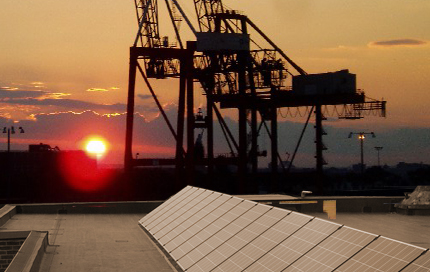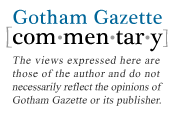
Looking out at New York Harbor from my window in Red Hook in Brooklyn, I imagine the water rising. Red Hook, before it was developed to handle the needs of a growing port in the 1800s, looked much like the wetlands of Jamaica Bay. It was a series of islands, some of which were below water at high tide. Global warming is a threat to the place, just as it is a threat to many low-lying areas of the city including the entire southern plains of Queens, Brooklyn and Staten Island.

Mayor Michael Bloomberg's PlaNYC notes that one way of reducing greenhouse gas emissions could be by moving from fossil fuel to solar energy. New Jersey and Long Island make solar power installation easy. Unfortunately New York does not offer much encouragement to the small homeowner who tries to convert to solar. On the contrary, it requires a permit process for rooftop installation of wind and solar systems that would make the old Soviet Union proud.
That said, living near the water forces you to take global warming seriously. So I set out to do my part by installing solar panels on my house. I imagined a project similar to stringing together a computer or stereo system would make me ready for the solar age and net metering. (Net metering allows daytime solar power to be moved to Con Edison's wires and nighttime power to be drawn from the system.) I was prepared to string a metal-sheathed cable from my roof to my electric meter and then plug a small windmill and solar panel into a DC/AC inverter and transformer. An electrician would then inspect what I did and wire it to my electric meter and I would be set. Total cost, I figured, would be $10,000 to $15,000 and while it would take some time for me to recover my investment, I assumed I would get there before the rising waters flooded my home.
The Rising Tide of Paperwork
What I found was a bureaucratic and featherbedding nightmare that could discourage the most ardent environmentalist. New York State Energy Research and Development Authority (NYSERDA), the city Department of Buildings, the Bureau of Electrical Control (whatever that is?), Underwriters Laboratories and Con Edison each have separate applications and work permits. A licensed architect must submit drawings. Three separate inspections of the installation must be made before the switch can be flipped. It has been reported that required approvals can take several years. The additional cost of all this government regulation more than cancels out the substantial tax incentives that government proudly provides in the name of encouraging energy independence.
Richard Klein operates Quixotic Systems, a small business that has installed more than 25 solar systems over the past three years. "Overregulation has brought the cost in New York up to the highest in the nation," Klein told me. "Government does not understand what a small business needs to develop a market or what a home owner can afford." Asked what can be done to make sustainable power work in New York City he quickly answered, "Consolidate permitting, streamline paperwork, have fewer entities involved."
The Energy Audit
For my project, I started with the New York State Energy Research and Development Authority. An agency representative at an Energy Smart Fair at Gateway National Recreation Area in Brooklyn told me the most likely way to reduce energy costs was by reducing the use of energy in my home. The state's Energy Research and Development Authority suggested an energy audit by one of their contractors. On the scheduled date of the audit, the contractor placed an airtight exhaust fan in my front doorway and began to measure places in my home where air was entering the building. They gave me good advice about insulation, promoted the Energy Star appliance program and noted places in my home that were not airtight enough. They told me that I had already made the big changes. The stove and furnace had electric pilot lights. The house was 99 percent compact fluorescent. All appliances except the toaster were Energy Star.
They followed up with a multi-page report. It concluded that I should replace three windows and a couple of doors and put down a new roof. Additionally, I should add some blow-in cellulose insulation to one corner of one floor of my home. The contractor's estimate for the work after tax rebates was $15,000. The work was eligible for tax rebates only if I did it with a certified contractor. My utility costs would be reduced by approximately $12 a month after work was completed. I can do the math.
There was no mention of solar or wind power in the report, even though I had mentioned them in my discussions with the contractor. In the end, the agency that should be promoting solar power throughout the state was silent.
Wind on the Roof
If it's so hard to install solar panels, how about wind power? Here in Red Hook the wind blows 24/7 for nine months of the year.
Small-scale windmills are not suitable for most New York City rooftops, but they also are discouraged by regulation. Installations of small rooftop windmills, even those that can be placed on a pole no more intrusive than a TV antenna, require the same permitting process that is needed to add a new floor to a building. There should be a way to develop a set of rules that says "yes, but" rather than "no, except."
There is much to look forward to in PlaNYC. New buildings will be constructed to be more energy efficient. Additional tax incentives will encourage rooftop solar. Green roofs and the use of succulent plants on specially designed roofs to reduce water flows to sewers are encouraged. Energy efficiency is promoted with new incentives. But PlaNYC must address the roadblocks presented by governments and utilities if we ever hope to see a significant move to renewable energy.
Looking down on Red Hook from the highest subway station in New York (the F line at Smith & 9th Streets), the bare black rooftops of the many buildings stretch to the waters' edge. There aren't even clotheslines on those roofs. Does everyone in the city use electricity or gas to dry clothes? PlaNYC says nothing about using rooftops to dry clothes.
Perhaps instead these roofs are the perfect place to build an ark in anticipation of the coming flood. I wonder how many permits are required.
Dave Lutz is the executive director of Neighborhood Open Space Coalition, which works for a healthier, greener city.
Back to the Sustainability Watch homepage
Â




